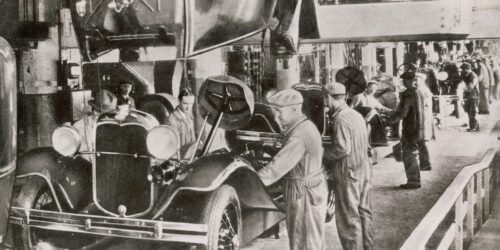
By definition, manufacturing is the transformation of raw materials into useful products. While this has been around since stone times, we’ve watched the process, as well as the efficiencies and capabilities associated, grow and change.
The First Notable Shifts
Manufacturing as we know it today began with the Industrial Revolution, when machines became a key player in how products were created. This era drove advancements in a variety of industries including agriculture, transportation, and fashion.
The second notable shift was the creation of the Assembly Line. Through implementing this methodology, Henry Ford reduced the time required to build an automobile in a way that now made these products accessible to the masses.
This new assembly line system trained employees in a very specific way in one step of the assembly process and transformed manufacturing facilities into spaces with continuous movement of products. This process continued to improve and develop through the years and is still used to this day.
LEAN Manufacturing
While these methods continued, more shifts and improvements were also taking place. The next piece of manufacturing was the implementation of Lean Manufacturing, which is the focus on eliminating waste.
Waste can appear in a variety of forms, including overproduction, defective products, excessive material usage, and the time required to complete a task.
Approaching lean manufacturing is a mix of multiple steps that require flexibility and alterations over time. Employees must understand that lean manufacturing is first a mindset with actions that then follow. Examples include mapping the flow of material, setting and tracking KPIs, intentional product improvements, and increasing visualization.
As waste is eliminated, operating costs and lead times are reduced, and customers receive higher quality products. Lean manufacturing is often paired with assembly lines and the processes of how products move throughout the plant.
Today in Manufacturing
Currently, manufacturing is at a notable point of introducing robotics, automation, and IIOT. These new shifts allow current employees to train and utilize their skills in meaningful ways and redisperse themselves throughout a facility. Mundane tasks can now be completed by a robot and tracked through automated data collection.
The goal is to reduce human error while increasing quality and efficiency. This new technology enables workers and companies to complete tasks quicker with more ergonomics.
BUILT Systems
BUILT Systems is transforming the manufacturing workplace into an efficient, ergonomic space. We understand that change is never-ending, which is why we create our products with modularity and growth in mind. Our products support the assembly line, LEAN manufacturing, and even complement today’s technology changes.
For example, machine bases are the perfect foundation for many robots and automated technology and BUILT workstations are compatible with SMART technology.
Ask yourself, where is your company at today in the timeline of manufacturing? Invest in your facility and the future of manufacturing with BUILT Systems. Our team is happy to answer any questions and be your support in finding solutions perfect for you.
